Carbograph: An Etching Technique Invented by Rand Huebsch
The printmaking technique of etching has been in use for about five hundred years. In the platemaking process, a sheet of metal (usually copper) is coated with "ground," an acid- resistant liquid petroleum product. When the ground has dried, a metal stylus is used on the plate to expose the areas of metal to be etched in the acid bath. Those areas, whether dots or lines, will comprise the printed image. After the etch, the ground is removed with mineral spirits or other solvent, and a thick paste-like ink is deposited into the etched lines of the plate. Then the plate and a sheet of paper are placed on an etching- press bed, which is cranked under a heavy roller, to transfer the ink to paper.
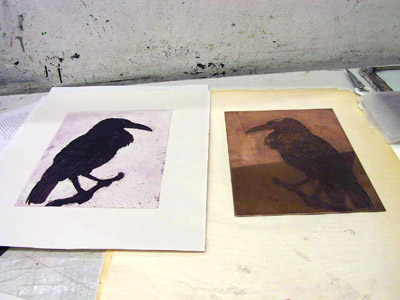
Inked etching plate (right) and print from it
In 2006 I created an etching variation called "carbograph." In that process, particles of carborundum grit are mixed into the ground before it is applied to the plate. (Carborundum is a compound of silica and carbon, first mass produced in the 19th century and used commercially as an abrasive.) When the etching stylus is then used on the dried mixture on the plate, some of the grit particles are removed. Tiny dots of copper are thereby exposed and then etched when the plate is put in the acid bath. Those areas will eventually hold the ink for the printing process, and the printed image on paper will have a look like that of a charcoal drawing.
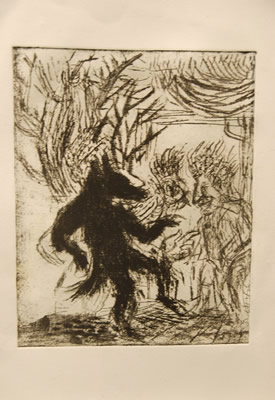
Doppelganger carbograph etching, 9" x 6" plate size
One variable in making the carbograph mixture is the grit coarseness, as that will determine the kind of dots that appear on the plate. The lower the designation, the coarser the grit. For example, #100 grit is coarser than #150 grit. The very finest grit will not be useful for the carbograph mixture. Try mixing a variety of grits into one container of ground. Alternative granular materials for use in a mixture are coarse salt and rosin. Keeping a record of the various grits and proportions is helpful for reference.
The ratio of grit to liquid ground is also important, as that influences the thickness of the mixture. Use about one teaspoon of grit to one ounce of liquid ground, for a fairly thick consistency. This is another of those aspects that the printmaker will fine tune with practice--and good record keeping..
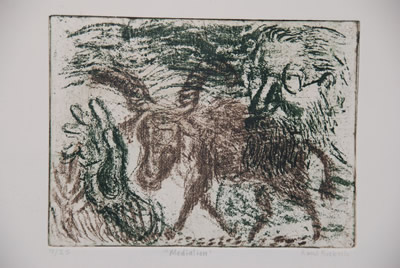
Mediation carbograph etching, 7" x 9" plate size
Two printing plates were used for this image.
When applying the mixture to the plate, periodically stir the container, as the grit tends to settle. Try brushing in one direction for one plate and in both directions for another plate. Experiment with how thickly to apply the mixture to the plate. Another variable is the type of brush used: hard bristle vs soft bristle. The brush strokes themselves can be circular or angular and, if strongly textured, can add character to the print image--almost in the way that wood grain can add to the quality of a wood cut. It is crucial that the ground, once applied to the plate, be allowed to dry thoroughly before the etching needle is used; otherwise the scraping motion will remove clumps of the ground.
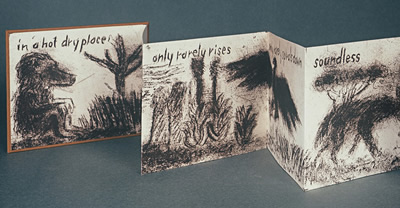
in a hot dry place
Accordion book, eight panels, each panel 6" x 5" The printing plates were regrounded and re-etched several times to achieve the desired density of tone.
One can also use the etching tool called a "scraper" to remove ground. Since the scraper can be held at varying angles to the plate, it can yield a range of line widths, unlike a stylus. Experiment with different degrees of scraper pressure, as well as the number of strokes or passes across a given area of the plate. Also use the scraper to remove entire areas of the ground, for an aquatint-like tone, once the plate is etched. The minute dots of that tone are black, rather than white as in traditional aquatint. In a variation on mezzotint printing, etch the entire grounded and scraped plate to a dark tone, remove the remaining ground, and then bring up light areas on the plate by using a burnishing tool to press down areas of metal so they will hold less ink.
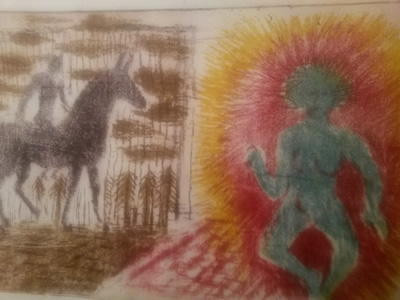
Encounter. 6"h x 8"w.
Two printing plates were used; each was inked with two colors.
After printing a first impression of the plate, one may wish to re-ground the plate with carbograph mixture,so as to make additions to it with the scraper, and do another etch. Because of the mixture's opacity, it may be hard for the printmaker to see what the pre-existing image is on the plate, and thereby know where to make additions. In that case, place a sheet of tracing paper on the first proof, draw the main outlines of the image, then transfer that to the regrounded plate by using Saral transfer paper placed underneath the tracing paper, and redrawing the main outlines onto the plate.
The carbograph process can of course be used in conjunction with other mark-making techniques. Those can either precede or follow the carbograph phase of platemaking. For example, first cover a plate with traditional ground, use a stylus to create fine lines, etch the plate, and remove the ground; then apply the carbograph mixture and use the scraper on the plate, to expose metal and establish areas of texture during the etch. Whether as the sole etching technique for platemaking, or as one of several processes, carbograph can yield a wide range of textures and effects.
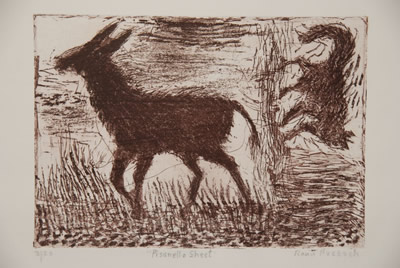
Pisanello Sheet
Carbograph etching, 6" x 9" plate size
Two techniques were used to make the printing plate for this image:
1) carbograph and 2)litho crayon as acid resist (for the cat).